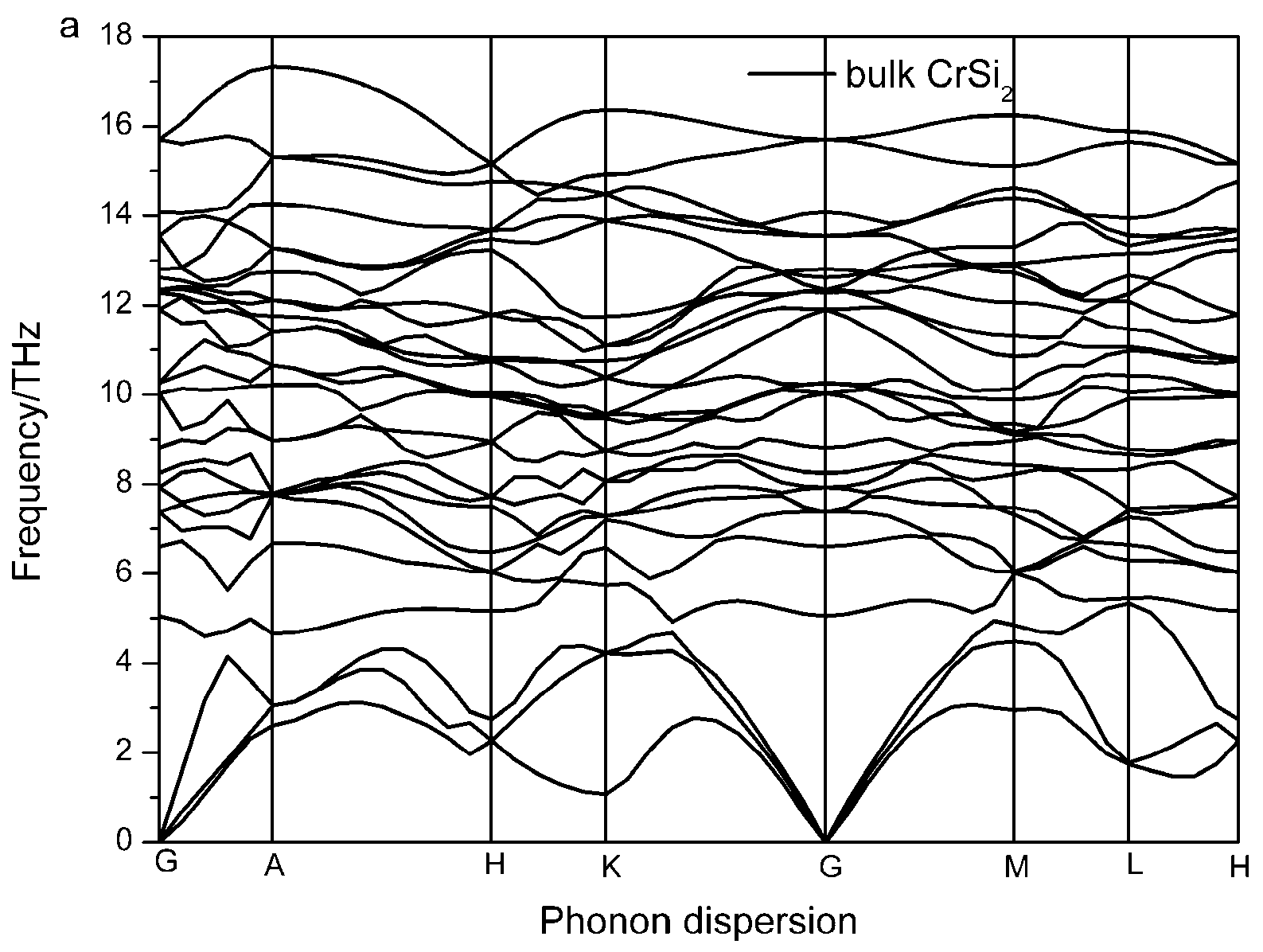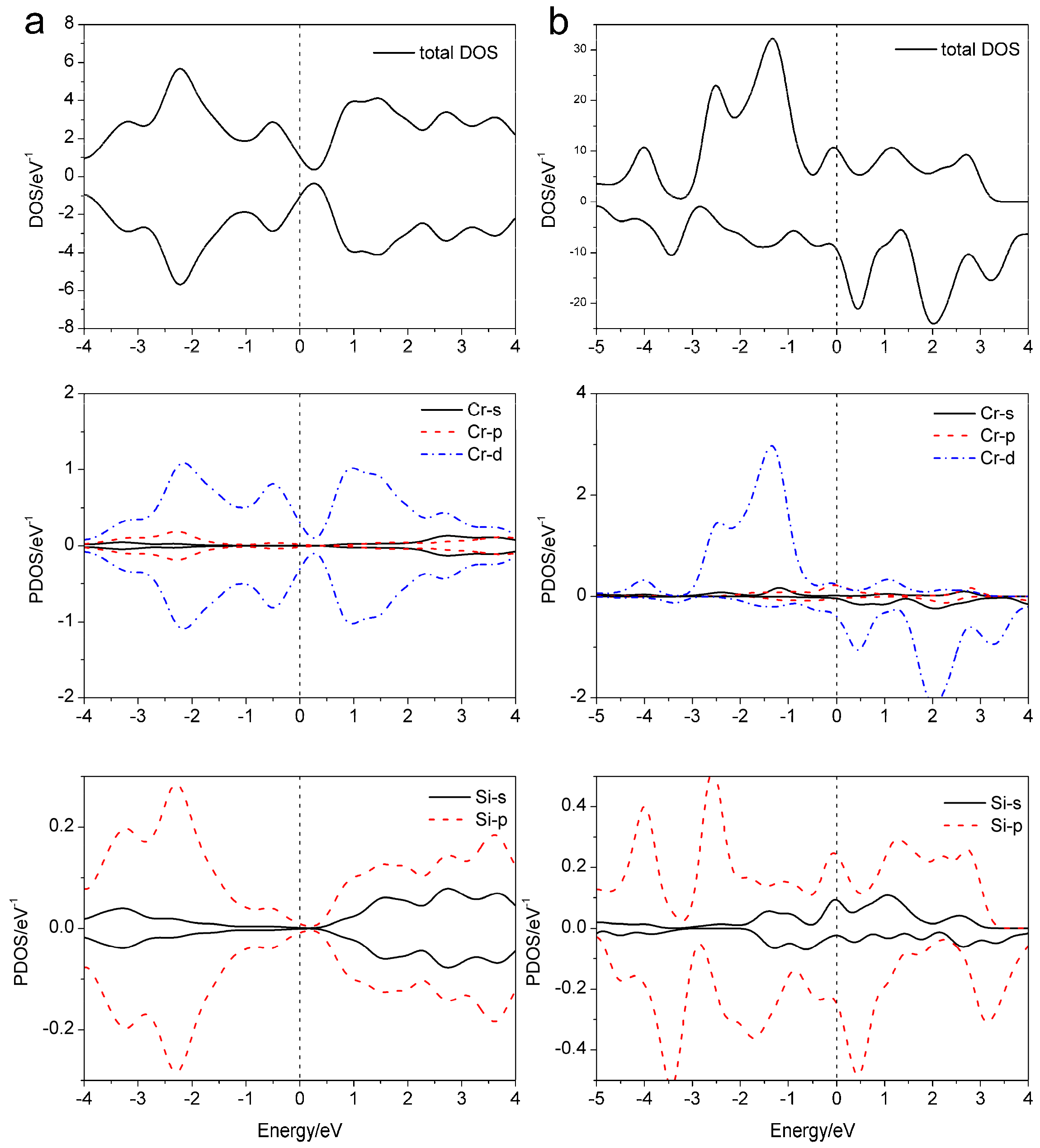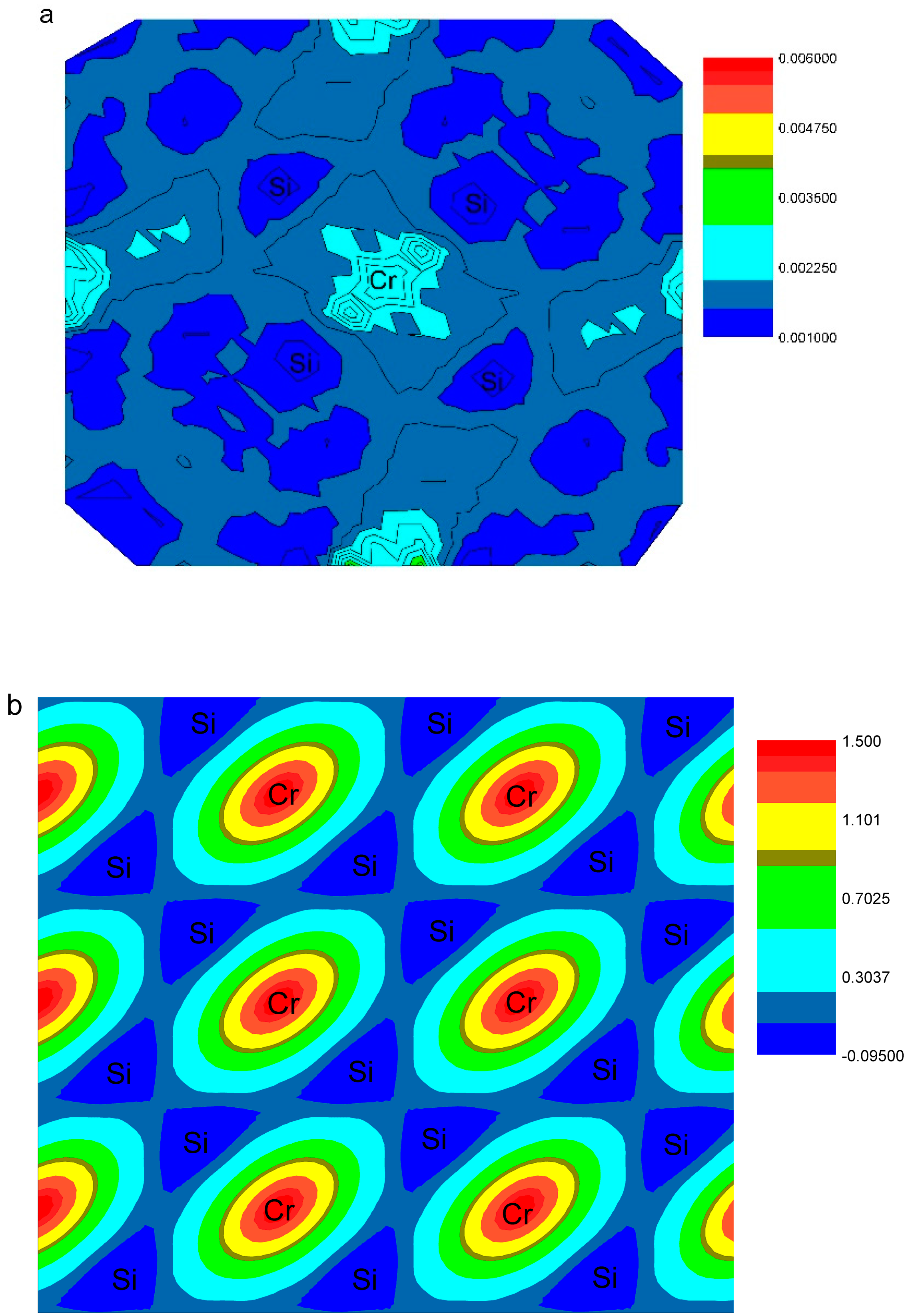Electronic and Magnetic Properties of Bulk and Monolayer CrSi2: A First-Principle Study
Abstract
1. Introduction
2. Material and Methods
3. Results and Discussion
3.1. Phonon Dispersion Curve
3.2. Electronic Structure
3.3. Magnetic Properties
4. Conclusions
Author Contributions
Funding
Acknowledgments
Conflicts of Interest
References
- Novoselov, K.S.; Geim, A.K.; Morozov, S.V.; Jiang, D.; Zhang, Y.; Dubonos, S.V.; Grigorieva, I.V.; Firsov, A.A. Electric field effect in atomically thin carbon films. Science 2004, 306, 666–669. [Google Scholar] [CrossRef] [PubMed]
- Xu, M.S.; Liang, T.; Shi, M.M.; Chen, H.Z. Graphene-like two-dimensional materials. Chem. Rev. 2013, 113, 3766–3798. [Google Scholar] [CrossRef] [PubMed]
- Lew Yan Voon, L.C.; Guzmán-Verri, G.G. Is silicone the next graphence. MRS Bull. 2014, 39, 366–373. [Google Scholar] [CrossRef]
- Kara, A.; Enriquez, H.; Seitsonen, A.P.; Lew Yan Voon, L.C.; Vizzini, S.; Aufray, B.; Oughaddou, H. A review on silicone-new candidate for electronics. Sur. Sci. Rep. 2012, 67, 1–18. [Google Scholar] [CrossRef]
- Golberg, D.; Bando, Y.; Huang, Y.; Terao, T.; Mitome, M.; Tang, C.; Zhi, C. Boron nitride nanotubes and nanosheets. ACS Nano 2010, 4, 2979–2993. [Google Scholar] [CrossRef] [PubMed]
- Pakdel, A.; Zhi, C.; Bando, Y.; Golberg, D. Low-dimensional boron nitride nanomaterials. Mat. Today 2012, 15, 256–265. [Google Scholar] [CrossRef]
- Chhowalla, M.; Shin, H.S.; Eda, G.; Li, L.J.; Loh, K.P.; Zhang, H. The chemistry of two-dimensional layered transition metal dichalcogenidenanosheets. Nat. Chem. 2013, 5, 263–275. [Google Scholar] [CrossRef] [PubMed]
- Butler, S.Z.; Hollen, S.M.; Cao, L.; Cui, Y.; Gupta, J.A. Progress, challenges, and opportunities in two-dimensional materials beyond grapheme. ACS Nano 2013, 7, 2898–2926. [Google Scholar] [CrossRef] [PubMed]
- Han, N.N.; Liu, H.S.; Zhao, J.J. Novel magnetic monolayers of transition metal silicide. J. Superconduct. Nov. Magn. 2015, 28, 1755–1758. [Google Scholar] [CrossRef]
- Chen, S.B.; Chen, Y.; Yan, W.J.; Zhou, S.Y.; Xiong, W.; Yao, X.X.; Qin, X.M. Magnetism and optical property of Mn-doped monolayer CrSi2 by first-principle study. J. Superconduct. Nov. Magn. 2017. [Google Scholar] [CrossRef]
- Chen, S.B.; Zhou, S.Y.; Yan, W.J.; Chen, Y.; Qin, X.M.; Xiong, W. Effect of Fe and Ti Substitution Doping on Magnetic Property of Monolayer CrSi2: A first-principle investigation. J. Superconduct. Nov. Magn. 2018. [Google Scholar] [CrossRef]
- Han, W.; Kawakami, R.K.; Gmitra, M.; Fabian, J. Graphene spintronics. Nat. Nanotechnol. 2014, 59, 794–807. [Google Scholar] [CrossRef] [PubMed]
- Maassen, J.; Ji, W.; Guo, H. Graphene spintronics: The role of ferromagnetic electrodes. Nano Lett. 2011, 11, 151–155. [Google Scholar] [CrossRef] [PubMed]
- Fuh, H.R.; Chang, K.W.; Hung, S.H.; Jeng, H.T. Two-dimensional magnetic semiconductors based on transition-metal dichalcogenides VX2 (X=S, Se, Te) and similar layered compounds VI2 and Co(OH)2. IEEE Magn. Lett. 2017, 8, 3101405. [Google Scholar] [CrossRef]
- Das Sarma, S.; Adam, S.; Hwang, E.H.; Rossi, E. Electronic transport in two dimensional graphene. Rev. Mod. Phys. 2011, 83, 407–470. [Google Scholar] [CrossRef]
- Parkin, S.; Yang, S.H. Memory on the racetrack. Nat. Nanotechnol. 2015, 10, 195–198. [Google Scholar] [CrossRef] [PubMed]
- Parkin, S.S.P.; Hayashi, M.; Thomas, L. Magnetic domain-wall racetrack memory. Science 2008, 320, 190–194. [Google Scholar] [CrossRef] [PubMed]
- Eda, G.; Fujita, T.; Yamaguchi, H.; Voiry, D.; Chen M Chhowalla, M. Coherent atomic and electronic heterostructures of single-layer MoS2. ACS Nano 2012, 6, 7311–7317. [Google Scholar] [CrossRef] [PubMed]
- Ci, L.; Song, L.; Jin, C.; Jariwala, D.; Wu, D.; Li, Y. Atomic layers of hybridized boron nitride and graphene domains. Nat. Mater. 2010, 9, 430–435. [Google Scholar] [CrossRef] [PubMed]
- Zhang, H.; Liu, L.M.; Lau, W.M. Dimension-dependent phase transition and magnetic properties of VS2. J. Mater. Chem. A 2013, 1, 10821–10828. [Google Scholar] [CrossRef]
- Abdul Wasey, A.H.M.; Soubhik, C.; Das, G.P. Quantum size effects in layered VX2 (X=S, Se) materials: Manifestation of metal to semimetal or semiconductor transition. J. Appl. Phys. 2015, 117, 064313. [Google Scholar] [CrossRef]
- Tan, C.L.; Sun, D.; Tian, X.H.; Huang, Y.W. First-principles investigation of phase stability, electronic structure and optical properties of MgZnO monolayer. Materials 2016, 9, 877. [Google Scholar] [CrossRef] [PubMed]
- Wang, W.D.; Bai, L.W.; Yang, C.G.; Fan, K.Q.; Xie, Y.; Lin, M.L. The electronic properties of O-doped pure and sulfur vacancy-defect monolayer WS2: A first-principles study. Materials 2018, 11, 218. [Google Scholar] [CrossRef] [PubMed]
- Krijn, M.P.C.M.; Eppenga, R. First-principles electronic structure and optical properties of CrSi2. Phys. Rev. B 1991, 44, 9042–9044. [Google Scholar] [CrossRef]
- Mattheiss, L.F. Electronic structure of CrSi2 and related refractory disilicides. Phys. Rev. B 1991, 43, 12549–12555. [Google Scholar] [CrossRef]
- Dasgupta, T.; Etourneau, J.; Chevalier, B.; Matar, S.F.; Umarji, A.M. Structural, thermal, and electrical properties of CrSi2. J. Appl. Phys. 2008, 103, 113516. [Google Scholar] [CrossRef]
- Singh, D.J.; Parker, D. Itinerant magnetism in doped semiconducting β-FeSi2 and CrSi2. Sci. Rep. 2013, 3, 3517. [Google Scholar] [CrossRef] [PubMed]
- Parker, D.; Singh, D.J. Very heavily electron-doped CrSi2 as a high performance high-temperature thermoelectric material. New J. Phys. 2012, 14, 033045. [Google Scholar] [CrossRef]
- Dzade N, Y.; Obodo, K.O.; Adjokatse, S.K. Silicene and transition metal based materials: Prediction of a two dimensional piezomagnet. J. Phys. Condens. Matter. 2010, 22, 375502–375509. [Google Scholar] [CrossRef] [PubMed]
- Viet Q, B.; Pham, T.T.; Nguyen, H.V.S.; Le, H.M. Transition metal (Fe and Cr) adsorptions on buckled and planar silicene monolayers: A density functional theory investigation. J. Phys. Chem. C 2013, 117, 23364–23371. [Google Scholar]
- Wang, X.Q.; Li, H.D.; Wang, J.T. Induced ferromagnetism in one-side semihydrogenated silicene and germanene. Phys. Chem. Chem. Phys. 2012, 14, 3031–3036. [Google Scholar] [CrossRef] [PubMed]
- Zhang, C.W.; Yan, S.S. First-principles study of ferromagnetism in two-dimensional silicene with Hydrogenation. J. Phys. Chem. C 2012, 116, 4163–4166. [Google Scholar] [CrossRef]
- Kaloni, T.P.; Gangopadhyay, S.; Singh, N.; Jones, B. Electronic properties of Mn-decorated silicene on hexagonal boron nitride. Phys. Rev. B 2013, 88, 235418. [Google Scholar] [CrossRef]
- Zhu, H.N.; Gao, K.Y.; Liu, B.X. Formation of n-type CrSi2 semiconductor layers on Si by high-current Cr ion implantation. J. Phys. D Appl. Phys. 2000, 33, L49–L52. [Google Scholar] [CrossRef]
- Perdew, J.P.; Burke, K.; Ernzerhof, M. Generalized gradient approximation made simple. Phys. Rev. Lett. 1996, 77, 3865–3868. [Google Scholar] [CrossRef] [PubMed]
- Payne, M.C.; Teter, M.P.; Allan, D.C.; Arias TA Joannopoulos, J.D. Iterative minimization techniques for ab initio total-energy calculations: Molecular dynamics and conjugate gradients. Rev. Mod. Phys. 1992, 64, 1064–1096. [Google Scholar] [CrossRef]
- Clark, S.J. First principles methods using CASTEP. Z. Kristall. 2005, 220, 567–570. [Google Scholar] [CrossRef]
- Kresse, G.; Joubert, D. Self-interaction correction to density-functional approximations for many-electron systems. Phys. Rev. B Condens. Matter Mater. Phys. 1999, 59, 1758–1775. [Google Scholar] [CrossRef]
- Monkhorst, H.J.; Pack, J.D. Special points for Brillouin-zone integrations. Phys. Rev. B 1976, 13, 5188–5192. [Google Scholar] [CrossRef]
- Zeng, Z.Y.; Yin, Z.Y.; Huang, X.; Li, H.; He, Q.Y.; Lu, G.; Boey, F.; Zhang, H. Single-layer semiconducting nanosheets: High-yield preparation and device fabrication. Angew. Chem. Int. Ed. 2011, 50, 11093–11097. [Google Scholar] [CrossRef] [PubMed]
- Hermet, P.; Khalil, M.; Viennois, R.; Beaudhuin, M.; Bourgogne, D.; Ravot, D. Revisited phonon assignment and electromechanical properties of chromium disilicide. RSC Adv. 2015, 5, 19106–19116. [Google Scholar] [CrossRef]
- Huang L, F.; Rondinelli, J.M. Stable MoSi2 nanofilms with controllable and high metallicity. Phys. Rev. Mater. 2017, 1, 063001-1–063001-6. [Google Scholar] [CrossRef]
- Chen, Q.; Wang, J.L. Structural, electronic, and magnetic properties of TMZn11O12 and TM2Zn10O12 clusters (TM = Sc, Ti, V, Cr, Mn, Fe, Co, Ni, and Cu). Chem. Phys. Lett. 2009, 474, 336–341. [Google Scholar] [CrossRef]
- Li, H.; Qi, X.; Wu, J.; Zeng, Z.; Wei, J.; Zhang, H. Investigation of MoS2 and graphene nanosheets by magnetic force microscopy. ACS Nano 2013, 7, 2842–2849. [Google Scholar] [CrossRef] [PubMed]
- Tongay, S.; Varnoosfaderani, S.S.; Appleton, B.R.; Wu, J.Q.; Hebard, A.F. Magnetic properties of MoS2: Existence of ferromagnetism. Appl. Phys. Lett. 2012, 101, 123105. [Google Scholar] [CrossRef]
- Li, X.M.; Tao, L.; Chen, Z.F.; Fang, H.; Li, X.S.; Wang, X.R.; Xu, J.B.; Zhu, H.W. Graphene and related two-dimensional materials: Structure-property relationships for electronics and optoelectronics. Appl. Phys. Rev. 2017, 4, 021306. [Google Scholar] [CrossRef]
- Li, Z.Q.; Chen, F. Ion beam modification of two-dimensional materials: Characterization, properties, and applications. Appl. Phys. Rev. 2017, 4, 011103. [Google Scholar] [CrossRef]








| Total Energy of System (ev) | Band Length of cr-si of Intralayer (å) | Band Gap (eV) | Lattice Parameter (Å) | ||||
|---|---|---|---|---|---|---|---|
| bulk CrSi2 | 4 × 10−4 | 0 | 0 | −8050.32 | 2.47, 2.52,2.55 | 0.376 | a = 4.4276 c = 6.3681 |
| 0 c | 0 c | 0 c | -- | 2.47 a, 2.55 a, 3.06 a | 0.35 a, 0.21 d | a = 4.42 a, 4.43 d c = 6.349 a, 6.36 d | |
| monolayer CrSi2 | 3.68 | 4.11 | −0.21 | −24118.24 | 2.55 | 0 | a = 4.4276 c = 15 |
| 3.6 b | 4.15 c | -- | -- | 2.56 b | 0 c | a = 3.93968 e c = 16.49899 e |
© 2018 by the authors. Licensee MDPI, Basel, Switzerland. This article is an open access article distributed under the terms and conditions of the Creative Commons Attribution (CC BY) license (http://creativecommons.org/licenses/by/4.0/).
Share and Cite
Chen, S.; Chen, Y.; Yan, W.; Zhou, S.; Qin, X.; Xiong, W.; Liu, L. Electronic and Magnetic Properties of Bulk and Monolayer CrSi2: A First-Principle Study. Appl. Sci. 2018, 8, 1885. https://doi.org/10.3390/app8101885
Chen S, Chen Y, Yan W, Zhou S, Qin X, Xiong W, Liu L. Electronic and Magnetic Properties of Bulk and Monolayer CrSi2: A First-Principle Study. Applied Sciences. 2018; 8(10):1885. https://doi.org/10.3390/app8101885
Chicago/Turabian StyleChen, Shaobo, Ying Chen, Wanjun Yan, Shiyun Zhou, Xinmao Qin, Wen Xiong, and Li Liu. 2018. "Electronic and Magnetic Properties of Bulk and Monolayer CrSi2: A First-Principle Study" Applied Sciences 8, no. 10: 1885. https://doi.org/10.3390/app8101885
APA StyleChen, S., Chen, Y., Yan, W., Zhou, S., Qin, X., Xiong, W., & Liu, L. (2018). Electronic and Magnetic Properties of Bulk and Monolayer CrSi2: A First-Principle Study. Applied Sciences, 8(10), 1885. https://doi.org/10.3390/app8101885





